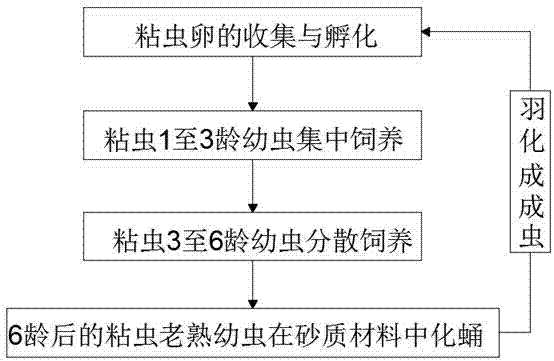Method for artificially feeding garmyworms in large scale
An armyworm and artificial technology, which is applied to the field of feeding armyworms, the prey of cockroaches in the biological control technology of tobacco pests, can solve the problems of high cost, poor air circulation, and easy disease and death of armyworms.
- Summary
- Abstract
- Description
- Claims
- Application Information
AI Technical Summary
Problems solved by technology
Method used
Image
Examples
Embodiment 1
[0019] For the collection and hatching of armyworm eggs, first fix a 10mm wide white high-quality plastic tape on the egg collection device for the attachment of armyworm eggs, and put the armyworm adults and 5% honey water adult nutrient solution in the egg laying stage. In the collection device, finally put the plastic belt with 5000 eggs in the plastic fresh-keeping bag and put it into the artificial climate box for batch incubation;
[0020] The 1st to 3rd instar larvae of the armyworm are reared intensively, and 5000 newly hatched larvae are placed in a sealable 100-mesh gauze breeding device, and are reared on a large scale in an artificial intelligence climate room;
[0021] The 3rd to 6th instar larvae of armyworm were reared separately, and one day after the 3rd instar larvae were reared intensively, 1000 armyworm larvae were scattered and placed in a breeding box of 57cm×37cm×8cm, and raised in an artificial intelligence climate room on a large scale;
[0022] The ma...
Embodiment 2
[0024] For the collection and hatching of armyworm eggs, first fix a 12.5mm wide white high-quality plastic tape on the egg-laying collection device for the armyworm eggs to attach to, and put the armyworm adults in the egg-laying stage and 5% honey water adult nutrient solution in the spawning stage. In the egg collection device, finally put the plastic belt with 5500 eggs in the plastic fresh-keeping bag and put it into the artificial climate box for batch hatching;
[0025] The 1st to 3rd instar larvae of armyworm were reared intensively, and 5250 newly hatched larvae were placed in a sealable 100-mesh gauze breeding device, and were reared on a large scale in an artificial intelligence climate room;
[0026] The 3rd to 6th instar larvae of the armyworm were reared separately, and 1.5 days after the 3rd instar larvae were reared intensively, 1250 armyworm larvae were scattered and placed in a 57cm×37cm×8cm breeding box, and raised in an artificial intelligence climate room o...
Embodiment 3
[0029] For the collection and hatching of armyworm eggs, first fix a 15mm wide white high-quality plastic tape on the egg-laying collection device for the armyworm eggs to attach to, and put the armyworm adults in the egg-laying stage and 5% honey water adult nutrient solution on the egg-laying stage. In the collection device, the plastic belt containing 6000 eggs is finally placed in a plastic fresh-keeping bag and placed in an artificial climate box for batch incubation;
[0030] The 1st to 3rd instar larvae of the armyworm were reared intensively, and 5,500 newly hatched larvae were placed in a sealable 100-mesh gauze breeding device, and were reared on a large scale in an artificial intelligence climate room;
[0031] The 3rd to 6th instar larvae of the armyworm were reared separately, and 2 days after the 3rd instar larvae were reared intensively, 1500 armyworm larvae were scattered and placed in a breeding box of 57cm×37cm×8cm, and raised in an artificial intelligence cli...
PUM
 Login to View More
Login to View More Abstract
Description
Claims
Application Information
 Login to View More
Login to View More - R&D
- Intellectual Property
- Life Sciences
- Materials
- Tech Scout
- Unparalleled Data Quality
- Higher Quality Content
- 60% Fewer Hallucinations
Browse by: Latest US Patents, China's latest patents, Technical Efficacy Thesaurus, Application Domain, Technology Topic, Popular Technical Reports.
© 2025 PatSnap. All rights reserved.Legal|Privacy policy|Modern Slavery Act Transparency Statement|Sitemap|About US| Contact US: help@patsnap.com

